Big Data Analytics and Business Intelligence Job Market Analysis
VerifiedAdded on 2022/08/12
|24
|6281
|37
Report
AI Summary
This research proposal examines the dynamic job market landscape of Big Data (BD) and Business Intelligence (BI). The study aims to compare the job opportunities offered by each domain, assess the demand for competencies in both BI and BD professionals, and identify the similarities and differences between BI and BD roles. The research includes a comprehensive literature review of BI and BD, discussing their definitions, applications, and impact on the job market. The methodology section outlines the research philosophy, approach, design, data collection methods, and ethical considerations. The proposal concludes with a timeline and expected outcomes, providing a clear framework for the research and its potential contributions to the field. The assignment is contributed by a student to be published on the website Desklib, a platform which provides all the necessary AI based study tools for students.
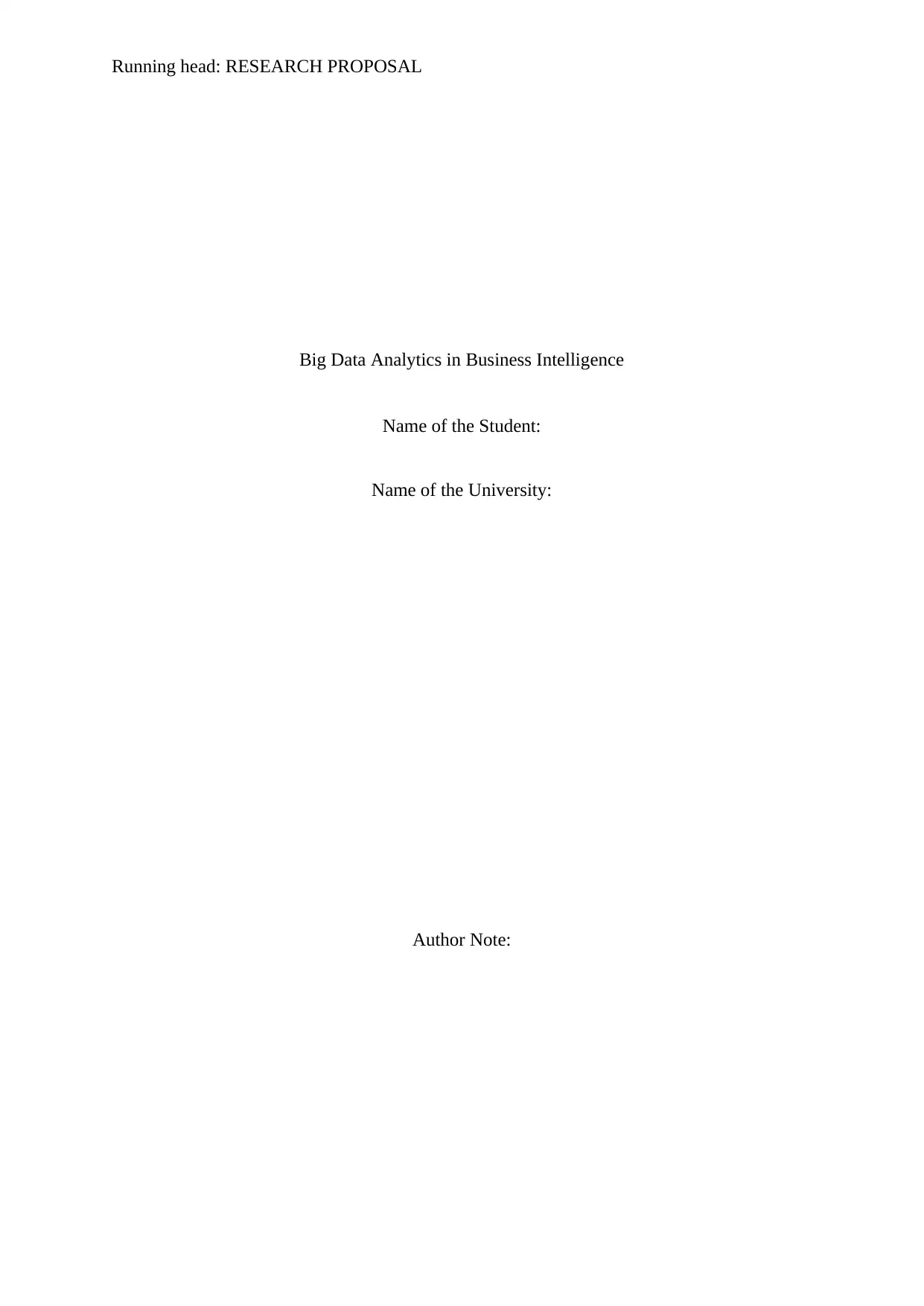
Running head: RESEARCH PROPOSAL
Big Data Analytics in Business Intelligence
Name of the Student:
Name of the University:
Author Note:
Big Data Analytics in Business Intelligence
Name of the Student:
Name of the University:
Author Note:
Paraphrase This Document
Need a fresh take? Get an instant paraphrase of this document with our AI Paraphraser
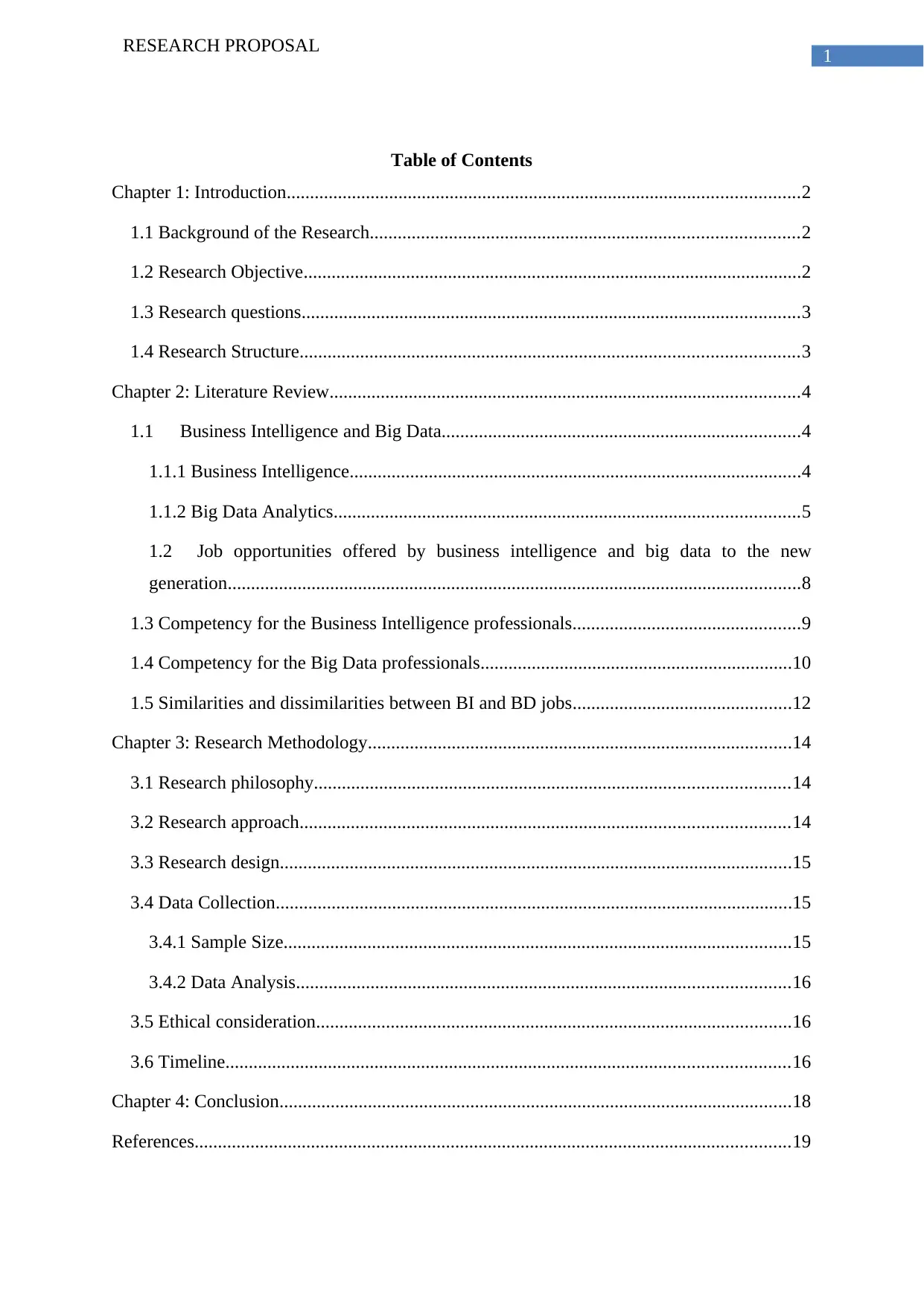
1
RESEARCH PROPOSAL
Table of Contents
Chapter 1: Introduction..............................................................................................................2
1.1 Background of the Research............................................................................................2
1.2 Research Objective...........................................................................................................2
1.3 Research questions...........................................................................................................3
1.4 Research Structure...........................................................................................................3
Chapter 2: Literature Review.....................................................................................................4
1.1 Business Intelligence and Big Data.............................................................................4
1.1.1 Business Intelligence.................................................................................................4
1.1.2 Big Data Analytics....................................................................................................5
1.2 Job opportunities offered by business intelligence and big data to the new
generation...........................................................................................................................8
1.3 Competency for the Business Intelligence professionals.................................................9
1.4 Competency for the Big Data professionals...................................................................10
1.5 Similarities and dissimilarities between BI and BD jobs...............................................12
Chapter 3: Research Methodology...........................................................................................14
3.1 Research philosophy......................................................................................................14
3.2 Research approach.........................................................................................................14
3.3 Research design..............................................................................................................15
3.4 Data Collection...............................................................................................................15
3.4.1 Sample Size.............................................................................................................15
3.4.2 Data Analysis..........................................................................................................16
3.5 Ethical consideration......................................................................................................16
3.6 Timeline.........................................................................................................................16
Chapter 4: Conclusion..............................................................................................................18
References................................................................................................................................19
RESEARCH PROPOSAL
Table of Contents
Chapter 1: Introduction..............................................................................................................2
1.1 Background of the Research............................................................................................2
1.2 Research Objective...........................................................................................................2
1.3 Research questions...........................................................................................................3
1.4 Research Structure...........................................................................................................3
Chapter 2: Literature Review.....................................................................................................4
1.1 Business Intelligence and Big Data.............................................................................4
1.1.1 Business Intelligence.................................................................................................4
1.1.2 Big Data Analytics....................................................................................................5
1.2 Job opportunities offered by business intelligence and big data to the new
generation...........................................................................................................................8
1.3 Competency for the Business Intelligence professionals.................................................9
1.4 Competency for the Big Data professionals...................................................................10
1.5 Similarities and dissimilarities between BI and BD jobs...............................................12
Chapter 3: Research Methodology...........................................................................................14
3.1 Research philosophy......................................................................................................14
3.2 Research approach.........................................................................................................14
3.3 Research design..............................................................................................................15
3.4 Data Collection...............................................................................................................15
3.4.1 Sample Size.............................................................................................................15
3.4.2 Data Analysis..........................................................................................................16
3.5 Ethical consideration......................................................................................................16
3.6 Timeline.........................................................................................................................16
Chapter 4: Conclusion..............................................................................................................18
References................................................................................................................................19
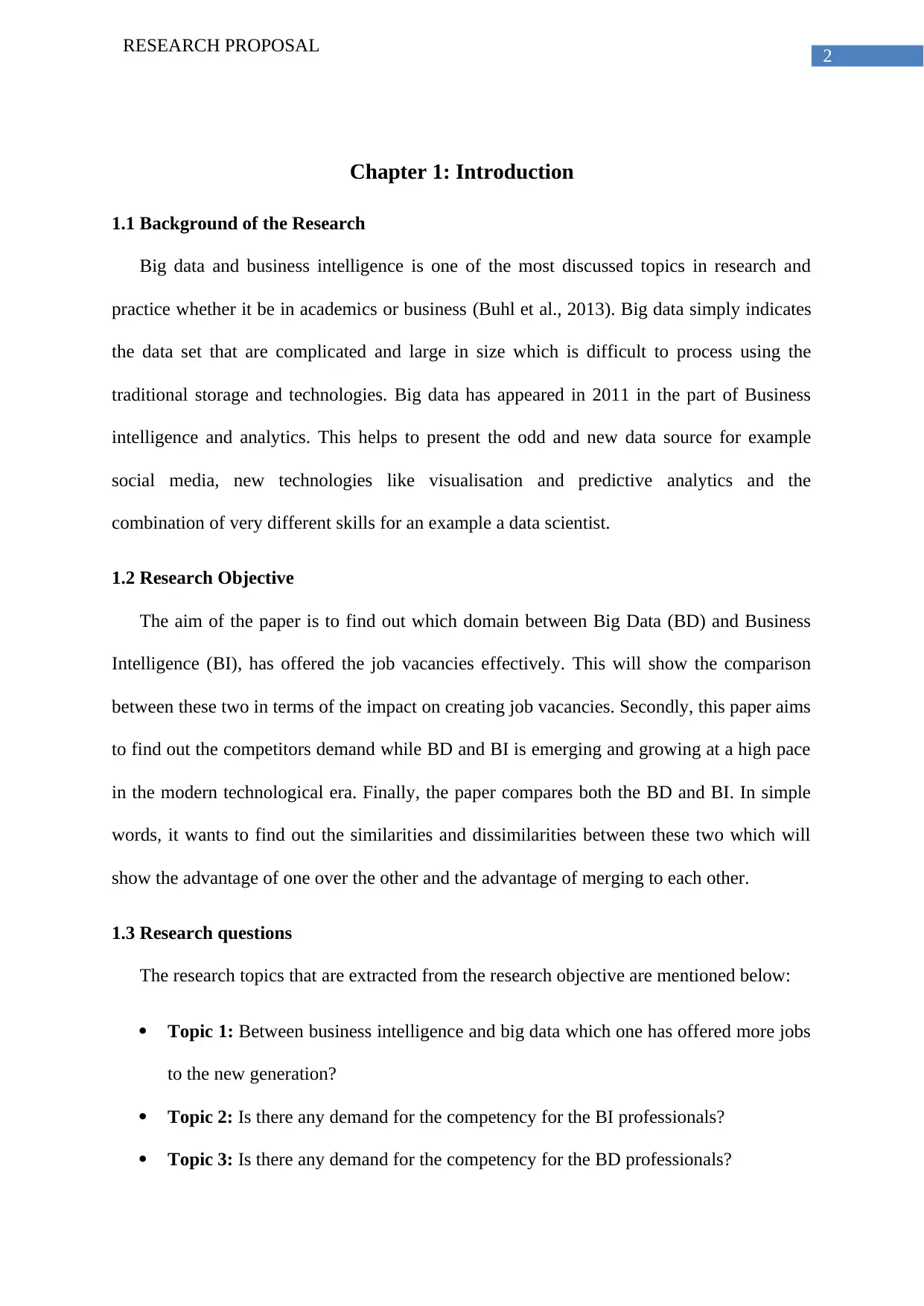
2
RESEARCH PROPOSAL
Chapter 1: Introduction
1.1 Background of the Research
Big data and business intelligence is one of the most discussed topics in research and
practice whether it be in academics or business (Buhl et al., 2013). Big data simply indicates
the data set that are complicated and large in size which is difficult to process using the
traditional storage and technologies. Big data has appeared in 2011 in the part of Business
intelligence and analytics. This helps to present the odd and new data source for example
social media, new technologies like visualisation and predictive analytics and the
combination of very different skills for an example a data scientist.
1.2 Research Objective
The aim of the paper is to find out which domain between Big Data (BD) and Business
Intelligence (BI), has offered the job vacancies effectively. This will show the comparison
between these two in terms of the impact on creating job vacancies. Secondly, this paper aims
to find out the competitors demand while BD and BI is emerging and growing at a high pace
in the modern technological era. Finally, the paper compares both the BD and BI. In simple
words, it wants to find out the similarities and dissimilarities between these two which will
show the advantage of one over the other and the advantage of merging to each other.
1.3 Research questions
The research topics that are extracted from the research objective are mentioned below:
Topic 1: Between business intelligence and big data which one has offered more jobs
to the new generation?
Topic 2: Is there any demand for the competency for the BI professionals?
Topic 3: Is there any demand for the competency for the BD professionals?
RESEARCH PROPOSAL
Chapter 1: Introduction
1.1 Background of the Research
Big data and business intelligence is one of the most discussed topics in research and
practice whether it be in academics or business (Buhl et al., 2013). Big data simply indicates
the data set that are complicated and large in size which is difficult to process using the
traditional storage and technologies. Big data has appeared in 2011 in the part of Business
intelligence and analytics. This helps to present the odd and new data source for example
social media, new technologies like visualisation and predictive analytics and the
combination of very different skills for an example a data scientist.
1.2 Research Objective
The aim of the paper is to find out which domain between Big Data (BD) and Business
Intelligence (BI), has offered the job vacancies effectively. This will show the comparison
between these two in terms of the impact on creating job vacancies. Secondly, this paper aims
to find out the competitors demand while BD and BI is emerging and growing at a high pace
in the modern technological era. Finally, the paper compares both the BD and BI. In simple
words, it wants to find out the similarities and dissimilarities between these two which will
show the advantage of one over the other and the advantage of merging to each other.
1.3 Research questions
The research topics that are extracted from the research objective are mentioned below:
Topic 1: Between business intelligence and big data which one has offered more jobs
to the new generation?
Topic 2: Is there any demand for the competency for the BI professionals?
Topic 3: Is there any demand for the competency for the BD professionals?
⊘ This is a preview!⊘
Do you want full access?
Subscribe today to unlock all pages.

Trusted by 1+ million students worldwide
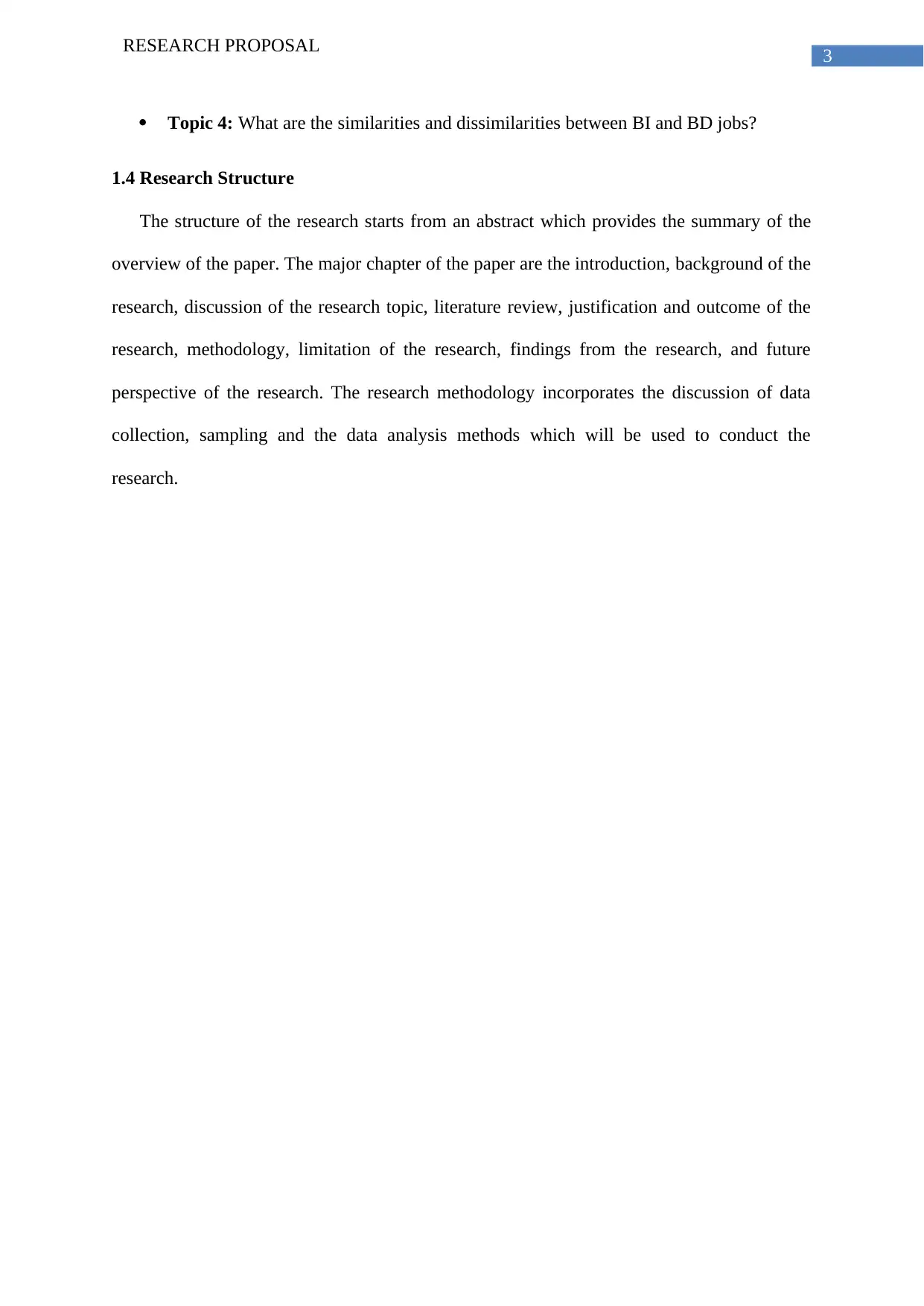
3
RESEARCH PROPOSAL
Topic 4: What are the similarities and dissimilarities between BI and BD jobs?
1.4 Research Structure
The structure of the research starts from an abstract which provides the summary of the
overview of the paper. The major chapter of the paper are the introduction, background of the
research, discussion of the research topic, literature review, justification and outcome of the
research, methodology, limitation of the research, findings from the research, and future
perspective of the research. The research methodology incorporates the discussion of data
collection, sampling and the data analysis methods which will be used to conduct the
research.
RESEARCH PROPOSAL
Topic 4: What are the similarities and dissimilarities between BI and BD jobs?
1.4 Research Structure
The structure of the research starts from an abstract which provides the summary of the
overview of the paper. The major chapter of the paper are the introduction, background of the
research, discussion of the research topic, literature review, justification and outcome of the
research, methodology, limitation of the research, findings from the research, and future
perspective of the research. The research methodology incorporates the discussion of data
collection, sampling and the data analysis methods which will be used to conduct the
research.
Paraphrase This Document
Need a fresh take? Get an instant paraphrase of this document with our AI Paraphraser
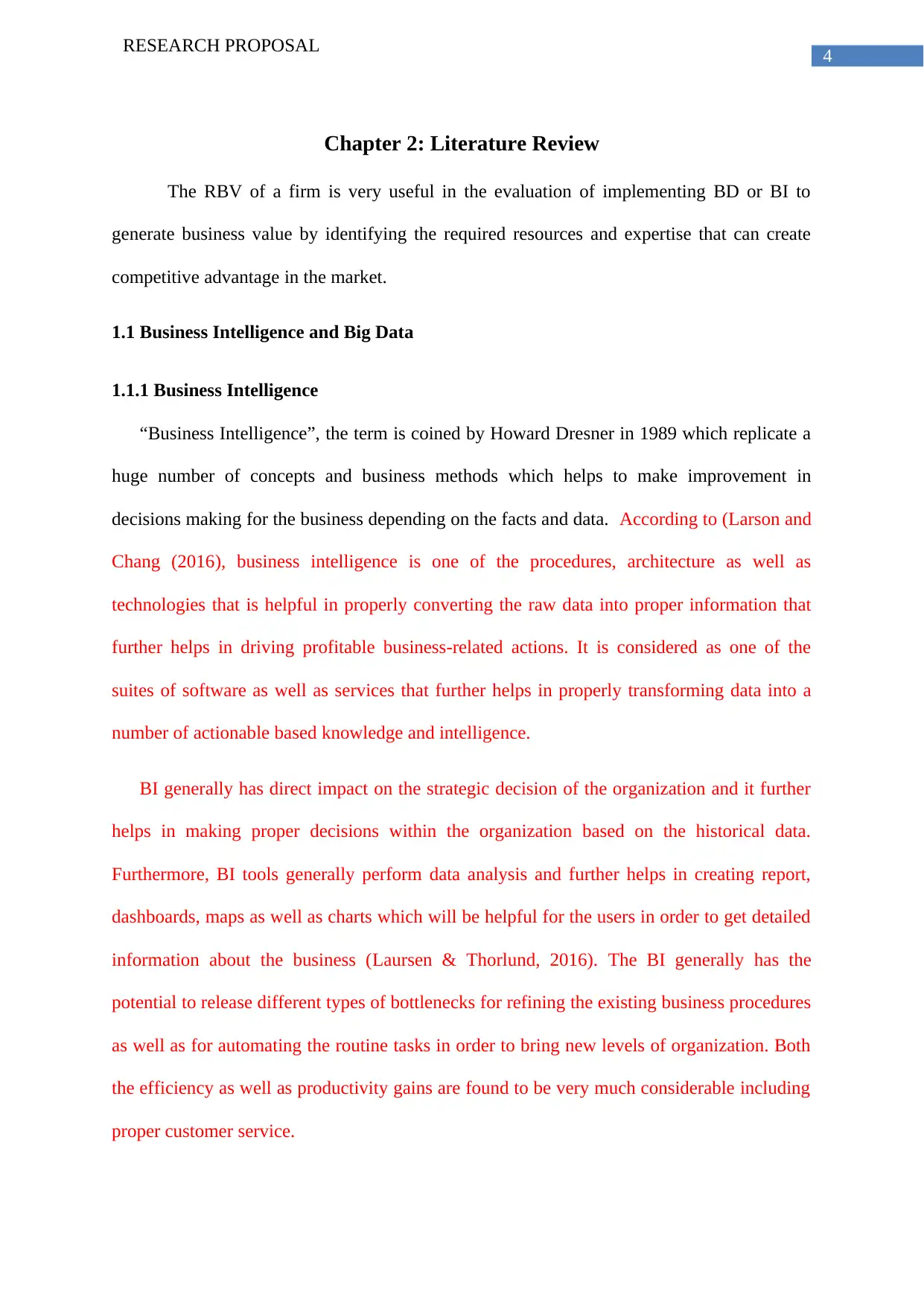
4
RESEARCH PROPOSAL
Chapter 2: Literature Review
The RBV of a firm is very useful in the evaluation of implementing BD or BI to
generate business value by identifying the required resources and expertise that can create
competitive advantage in the market.
1.1 Business Intelligence and Big Data
1.1.1 Business Intelligence
“Business Intelligence”, the term is coined by Howard Dresner in 1989 which replicate a
huge number of concepts and business methods which helps to make improvement in
decisions making for the business depending on the facts and data. According to (Larson and
Chang (2016), business intelligence is one of the procedures, architecture as well as
technologies that is helpful in properly converting the raw data into proper information that
further helps in driving profitable business-related actions. It is considered as one of the
suites of software as well as services that further helps in properly transforming data into a
number of actionable based knowledge and intelligence.
BI generally has direct impact on the strategic decision of the organization and it further
helps in making proper decisions within the organization based on the historical data.
Furthermore, BI tools generally perform data analysis and further helps in creating report,
dashboards, maps as well as charts which will be helpful for the users in order to get detailed
information about the business (Laursen & Thorlund, 2016). The BI generally has the
potential to release different types of bottlenecks for refining the existing business procedures
as well as for automating the routine tasks in order to bring new levels of organization. Both
the efficiency as well as productivity gains are found to be very much considerable including
proper customer service.
RESEARCH PROPOSAL
Chapter 2: Literature Review
The RBV of a firm is very useful in the evaluation of implementing BD or BI to
generate business value by identifying the required resources and expertise that can create
competitive advantage in the market.
1.1 Business Intelligence and Big Data
1.1.1 Business Intelligence
“Business Intelligence”, the term is coined by Howard Dresner in 1989 which replicate a
huge number of concepts and business methods which helps to make improvement in
decisions making for the business depending on the facts and data. According to (Larson and
Chang (2016), business intelligence is one of the procedures, architecture as well as
technologies that is helpful in properly converting the raw data into proper information that
further helps in driving profitable business-related actions. It is considered as one of the
suites of software as well as services that further helps in properly transforming data into a
number of actionable based knowledge and intelligence.
BI generally has direct impact on the strategic decision of the organization and it further
helps in making proper decisions within the organization based on the historical data.
Furthermore, BI tools generally perform data analysis and further helps in creating report,
dashboards, maps as well as charts which will be helpful for the users in order to get detailed
information about the business (Laursen & Thorlund, 2016). The BI generally has the
potential to release different types of bottlenecks for refining the existing business procedures
as well as for automating the routine tasks in order to bring new levels of organization. Both
the efficiency as well as productivity gains are found to be very much considerable including
proper customer service.
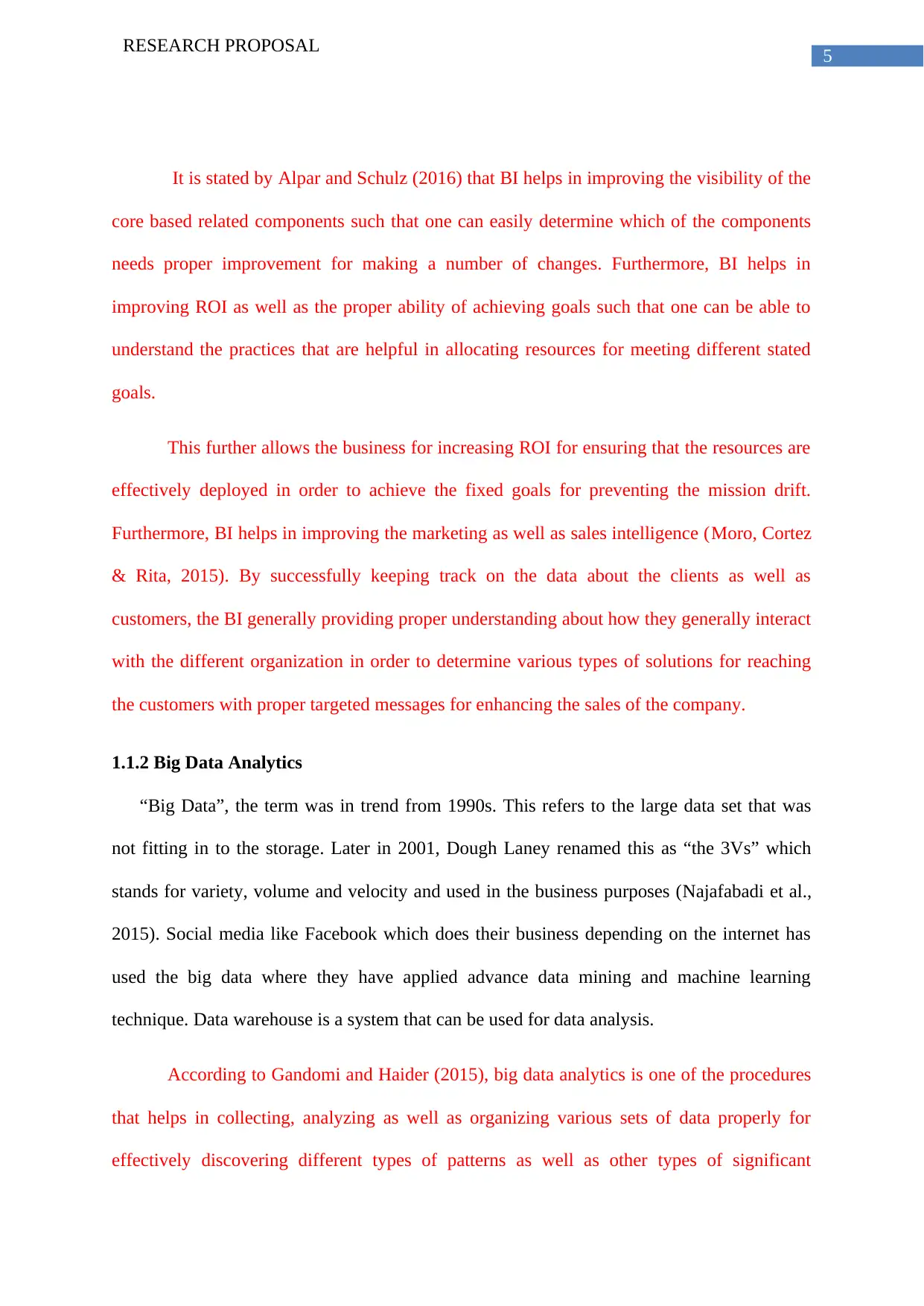
5
RESEARCH PROPOSAL
It is stated by Alpar and Schulz (2016) that BI helps in improving the visibility of the
core based related components such that one can easily determine which of the components
needs proper improvement for making a number of changes. Furthermore, BI helps in
improving ROI as well as the proper ability of achieving goals such that one can be able to
understand the practices that are helpful in allocating resources for meeting different stated
goals.
This further allows the business for increasing ROI for ensuring that the resources are
effectively deployed in order to achieve the fixed goals for preventing the mission drift.
Furthermore, BI helps in improving the marketing as well as sales intelligence (Moro, Cortez
& Rita, 2015). By successfully keeping track on the data about the clients as well as
customers, the BI generally providing proper understanding about how they generally interact
with the different organization in order to determine various types of solutions for reaching
the customers with proper targeted messages for enhancing the sales of the company.
1.1.2 Big Data Analytics
“Big Data”, the term was in trend from 1990s. This refers to the large data set that was
not fitting in to the storage. Later in 2001, Dough Laney renamed this as “the 3Vs” which
stands for variety, volume and velocity and used in the business purposes (Najafabadi et al.,
2015). Social media like Facebook which does their business depending on the internet has
used the big data where they have applied advance data mining and machine learning
technique. Data warehouse is a system that can be used for data analysis.
According to Gandomi and Haider (2015), big data analytics is one of the procedures
that helps in collecting, analyzing as well as organizing various sets of data properly for
effectively discovering different types of patterns as well as other types of significant
RESEARCH PROPOSAL
It is stated by Alpar and Schulz (2016) that BI helps in improving the visibility of the
core based related components such that one can easily determine which of the components
needs proper improvement for making a number of changes. Furthermore, BI helps in
improving ROI as well as the proper ability of achieving goals such that one can be able to
understand the practices that are helpful in allocating resources for meeting different stated
goals.
This further allows the business for increasing ROI for ensuring that the resources are
effectively deployed in order to achieve the fixed goals for preventing the mission drift.
Furthermore, BI helps in improving the marketing as well as sales intelligence (Moro, Cortez
& Rita, 2015). By successfully keeping track on the data about the clients as well as
customers, the BI generally providing proper understanding about how they generally interact
with the different organization in order to determine various types of solutions for reaching
the customers with proper targeted messages for enhancing the sales of the company.
1.1.2 Big Data Analytics
“Big Data”, the term was in trend from 1990s. This refers to the large data set that was
not fitting in to the storage. Later in 2001, Dough Laney renamed this as “the 3Vs” which
stands for variety, volume and velocity and used in the business purposes (Najafabadi et al.,
2015). Social media like Facebook which does their business depending on the internet has
used the big data where they have applied advance data mining and machine learning
technique. Data warehouse is a system that can be used for data analysis.
According to Gandomi and Haider (2015), big data analytics is one of the procedures
that helps in collecting, analyzing as well as organizing various sets of data properly for
effectively discovering different types of patterns as well as other types of significant
⊘ This is a preview!⊘
Do you want full access?
Subscribe today to unlock all pages.

Trusted by 1+ million students worldwide
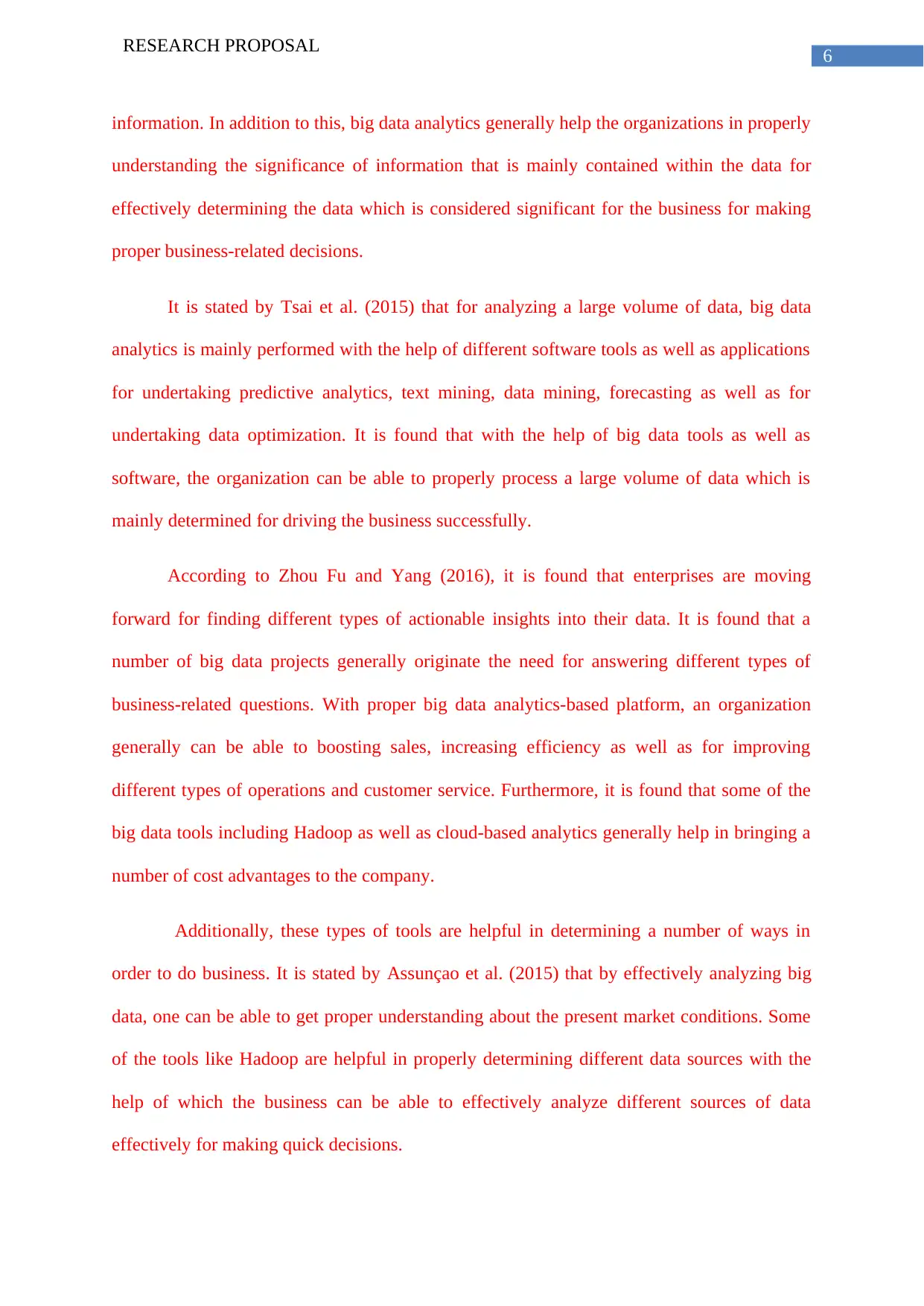
6
RESEARCH PROPOSAL
information. In addition to this, big data analytics generally help the organizations in properly
understanding the significance of information that is mainly contained within the data for
effectively determining the data which is considered significant for the business for making
proper business-related decisions.
It is stated by Tsai et al. (2015) that for analyzing a large volume of data, big data
analytics is mainly performed with the help of different software tools as well as applications
for undertaking predictive analytics, text mining, data mining, forecasting as well as for
undertaking data optimization. It is found that with the help of big data tools as well as
software, the organization can be able to properly process a large volume of data which is
mainly determined for driving the business successfully.
According to Zhou Fu and Yang (2016), it is found that enterprises are moving
forward for finding different types of actionable insights into their data. It is found that a
number of big data projects generally originate the need for answering different types of
business-related questions. With proper big data analytics-based platform, an organization
generally can be able to boosting sales, increasing efficiency as well as for improving
different types of operations and customer service. Furthermore, it is found that some of the
big data tools including Hadoop as well as cloud-based analytics generally help in bringing a
number of cost advantages to the company.
Additionally, these types of tools are helpful in determining a number of ways in
order to do business. It is stated by Assunçao et al. (2015) that by effectively analyzing big
data, one can be able to get proper understanding about the present market conditions. Some
of the tools like Hadoop are helpful in properly determining different data sources with the
help of which the business can be able to effectively analyze different sources of data
effectively for making quick decisions.
RESEARCH PROPOSAL
information. In addition to this, big data analytics generally help the organizations in properly
understanding the significance of information that is mainly contained within the data for
effectively determining the data which is considered significant for the business for making
proper business-related decisions.
It is stated by Tsai et al. (2015) that for analyzing a large volume of data, big data
analytics is mainly performed with the help of different software tools as well as applications
for undertaking predictive analytics, text mining, data mining, forecasting as well as for
undertaking data optimization. It is found that with the help of big data tools as well as
software, the organization can be able to properly process a large volume of data which is
mainly determined for driving the business successfully.
According to Zhou Fu and Yang (2016), it is found that enterprises are moving
forward for finding different types of actionable insights into their data. It is found that a
number of big data projects generally originate the need for answering different types of
business-related questions. With proper big data analytics-based platform, an organization
generally can be able to boosting sales, increasing efficiency as well as for improving
different types of operations and customer service. Furthermore, it is found that some of the
big data tools including Hadoop as well as cloud-based analytics generally help in bringing a
number of cost advantages to the company.
Additionally, these types of tools are helpful in determining a number of ways in
order to do business. It is stated by Assunçao et al. (2015) that by effectively analyzing big
data, one can be able to get proper understanding about the present market conditions. Some
of the tools like Hadoop are helpful in properly determining different data sources with the
help of which the business can be able to effectively analyze different sources of data
effectively for making quick decisions.
Paraphrase This Document
Need a fresh take? Get an instant paraphrase of this document with our AI Paraphraser

7
RESEARCH PROPOSAL
RESEARCH PROPOSAL
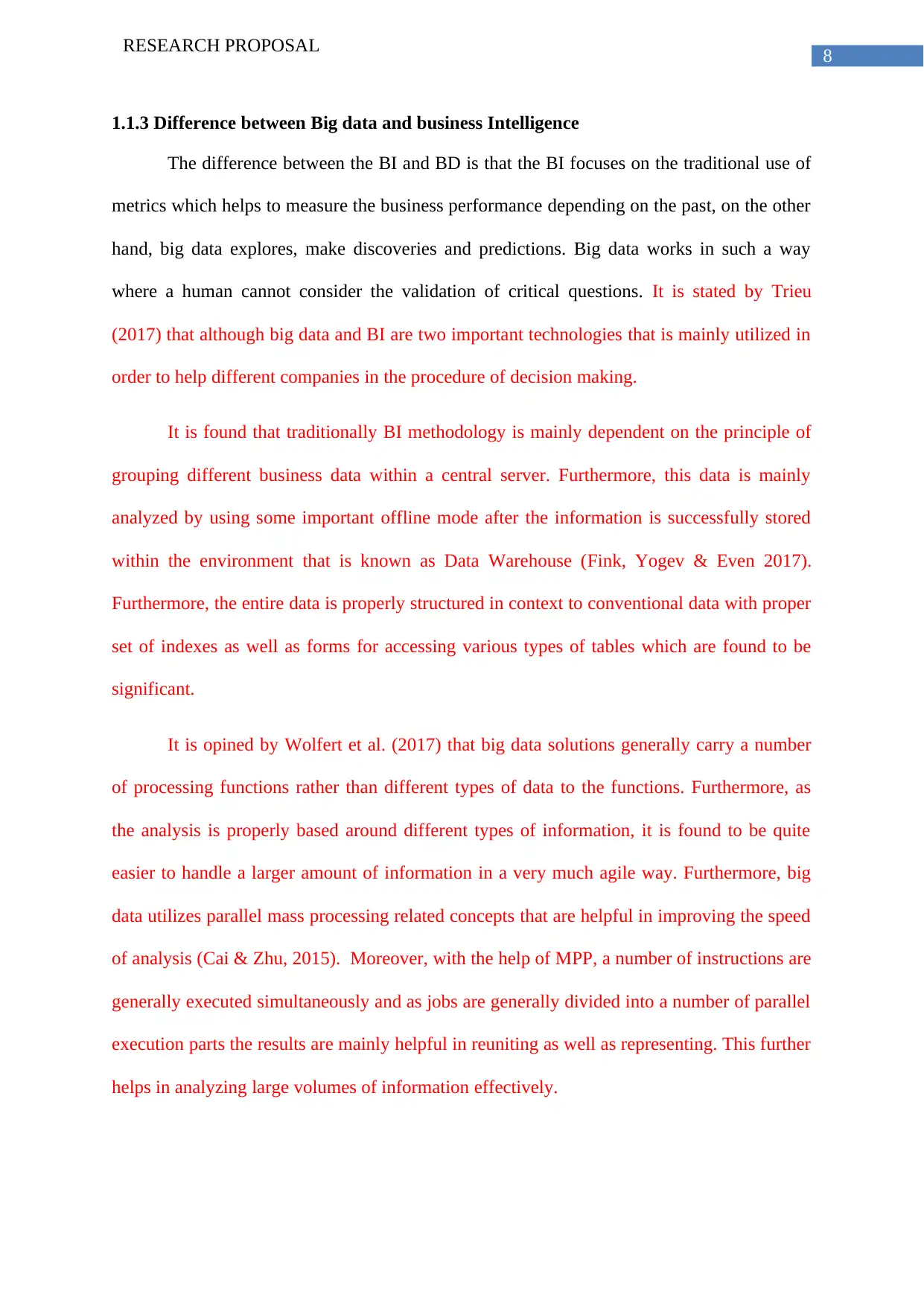
8
RESEARCH PROPOSAL
1.1.3 Difference between Big data and business Intelligence
The difference between the BI and BD is that the BI focuses on the traditional use of
metrics which helps to measure the business performance depending on the past, on the other
hand, big data explores, make discoveries and predictions. Big data works in such a way
where a human cannot consider the validation of critical questions. It is stated by Trieu
(2017) that although big data and BI are two important technologies that is mainly utilized in
order to help different companies in the procedure of decision making.
It is found that traditionally BI methodology is mainly dependent on the principle of
grouping different business data within a central server. Furthermore, this data is mainly
analyzed by using some important offline mode after the information is successfully stored
within the environment that is known as Data Warehouse (Fink, Yogev & Even 2017).
Furthermore, the entire data is properly structured in context to conventional data with proper
set of indexes as well as forms for accessing various types of tables which are found to be
significant.
It is opined by Wolfert et al. (2017) that big data solutions generally carry a number
of processing functions rather than different types of data to the functions. Furthermore, as
the analysis is properly based around different types of information, it is found to be quite
easier to handle a larger amount of information in a very much agile way. Furthermore, big
data utilizes parallel mass processing related concepts that are helpful in improving the speed
of analysis (Cai & Zhu, 2015). Moreover, with the help of MPP, a number of instructions are
generally executed simultaneously and as jobs are generally divided into a number of parallel
execution parts the results are mainly helpful in reuniting as well as representing. This further
helps in analyzing large volumes of information effectively.
RESEARCH PROPOSAL
1.1.3 Difference between Big data and business Intelligence
The difference between the BI and BD is that the BI focuses on the traditional use of
metrics which helps to measure the business performance depending on the past, on the other
hand, big data explores, make discoveries and predictions. Big data works in such a way
where a human cannot consider the validation of critical questions. It is stated by Trieu
(2017) that although big data and BI are two important technologies that is mainly utilized in
order to help different companies in the procedure of decision making.
It is found that traditionally BI methodology is mainly dependent on the principle of
grouping different business data within a central server. Furthermore, this data is mainly
analyzed by using some important offline mode after the information is successfully stored
within the environment that is known as Data Warehouse (Fink, Yogev & Even 2017).
Furthermore, the entire data is properly structured in context to conventional data with proper
set of indexes as well as forms for accessing various types of tables which are found to be
significant.
It is opined by Wolfert et al. (2017) that big data solutions generally carry a number
of processing functions rather than different types of data to the functions. Furthermore, as
the analysis is properly based around different types of information, it is found to be quite
easier to handle a larger amount of information in a very much agile way. Furthermore, big
data utilizes parallel mass processing related concepts that are helpful in improving the speed
of analysis (Cai & Zhu, 2015). Moreover, with the help of MPP, a number of instructions are
generally executed simultaneously and as jobs are generally divided into a number of parallel
execution parts the results are mainly helpful in reuniting as well as representing. This further
helps in analyzing large volumes of information effectively.
⊘ This is a preview!⊘
Do you want full access?
Subscribe today to unlock all pages.

Trusted by 1+ million students worldwide
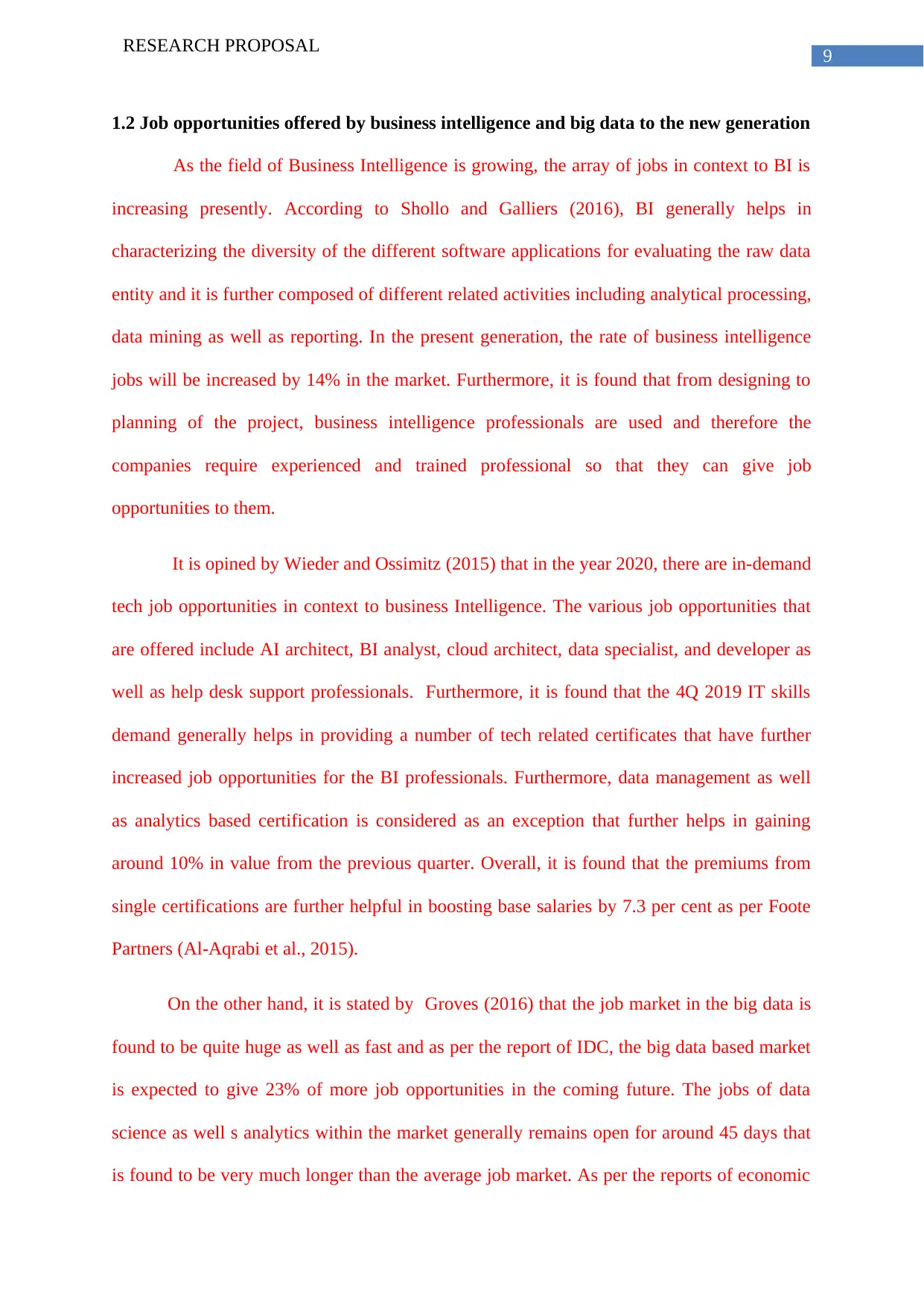
9
RESEARCH PROPOSAL
1.2 Job opportunities offered by business intelligence and big data to the new generation
As the field of Business Intelligence is growing, the array of jobs in context to BI is
increasing presently. According to Shollo and Galliers (2016), BI generally helps in
characterizing the diversity of the different software applications for evaluating the raw data
entity and it is further composed of different related activities including analytical processing,
data mining as well as reporting. In the present generation, the rate of business intelligence
jobs will be increased by 14% in the market. Furthermore, it is found that from designing to
planning of the project, business intelligence professionals are used and therefore the
companies require experienced and trained professional so that they can give job
opportunities to them.
It is opined by Wieder and Ossimitz (2015) that in the year 2020, there are in-demand
tech job opportunities in context to business Intelligence. The various job opportunities that
are offered include AI architect, BI analyst, cloud architect, data specialist, and developer as
well as help desk support professionals. Furthermore, it is found that the 4Q 2019 IT skills
demand generally helps in providing a number of tech related certificates that have further
increased job opportunities for the BI professionals. Furthermore, data management as well
as analytics based certification is considered as an exception that further helps in gaining
around 10% in value from the previous quarter. Overall, it is found that the premiums from
single certifications are further helpful in boosting base salaries by 7.3 per cent as per Foote
Partners (Al-Aqrabi et al., 2015).
On the other hand, it is stated by Groves (2016) that the job market in the big data is
found to be quite huge as well as fast and as per the report of IDC, the big data based market
is expected to give 23% of more job opportunities in the coming future. The jobs of data
science as well s analytics within the market generally remains open for around 45 days that
is found to be very much longer than the average job market. As per the reports of economic
RESEARCH PROPOSAL
1.2 Job opportunities offered by business intelligence and big data to the new generation
As the field of Business Intelligence is growing, the array of jobs in context to BI is
increasing presently. According to Shollo and Galliers (2016), BI generally helps in
characterizing the diversity of the different software applications for evaluating the raw data
entity and it is further composed of different related activities including analytical processing,
data mining as well as reporting. In the present generation, the rate of business intelligence
jobs will be increased by 14% in the market. Furthermore, it is found that from designing to
planning of the project, business intelligence professionals are used and therefore the
companies require experienced and trained professional so that they can give job
opportunities to them.
It is opined by Wieder and Ossimitz (2015) that in the year 2020, there are in-demand
tech job opportunities in context to business Intelligence. The various job opportunities that
are offered include AI architect, BI analyst, cloud architect, data specialist, and developer as
well as help desk support professionals. Furthermore, it is found that the 4Q 2019 IT skills
demand generally helps in providing a number of tech related certificates that have further
increased job opportunities for the BI professionals. Furthermore, data management as well
as analytics based certification is considered as an exception that further helps in gaining
around 10% in value from the previous quarter. Overall, it is found that the premiums from
single certifications are further helpful in boosting base salaries by 7.3 per cent as per Foote
Partners (Al-Aqrabi et al., 2015).
On the other hand, it is stated by Groves (2016) that the job market in the big data is
found to be quite huge as well as fast and as per the report of IDC, the big data based market
is expected to give 23% of more job opportunities in the coming future. The jobs of data
science as well s analytics within the market generally remains open for around 45 days that
is found to be very much longer than the average job market. As per the reports of economic
Paraphrase This Document
Need a fresh take? Get an instant paraphrase of this document with our AI Paraphraser
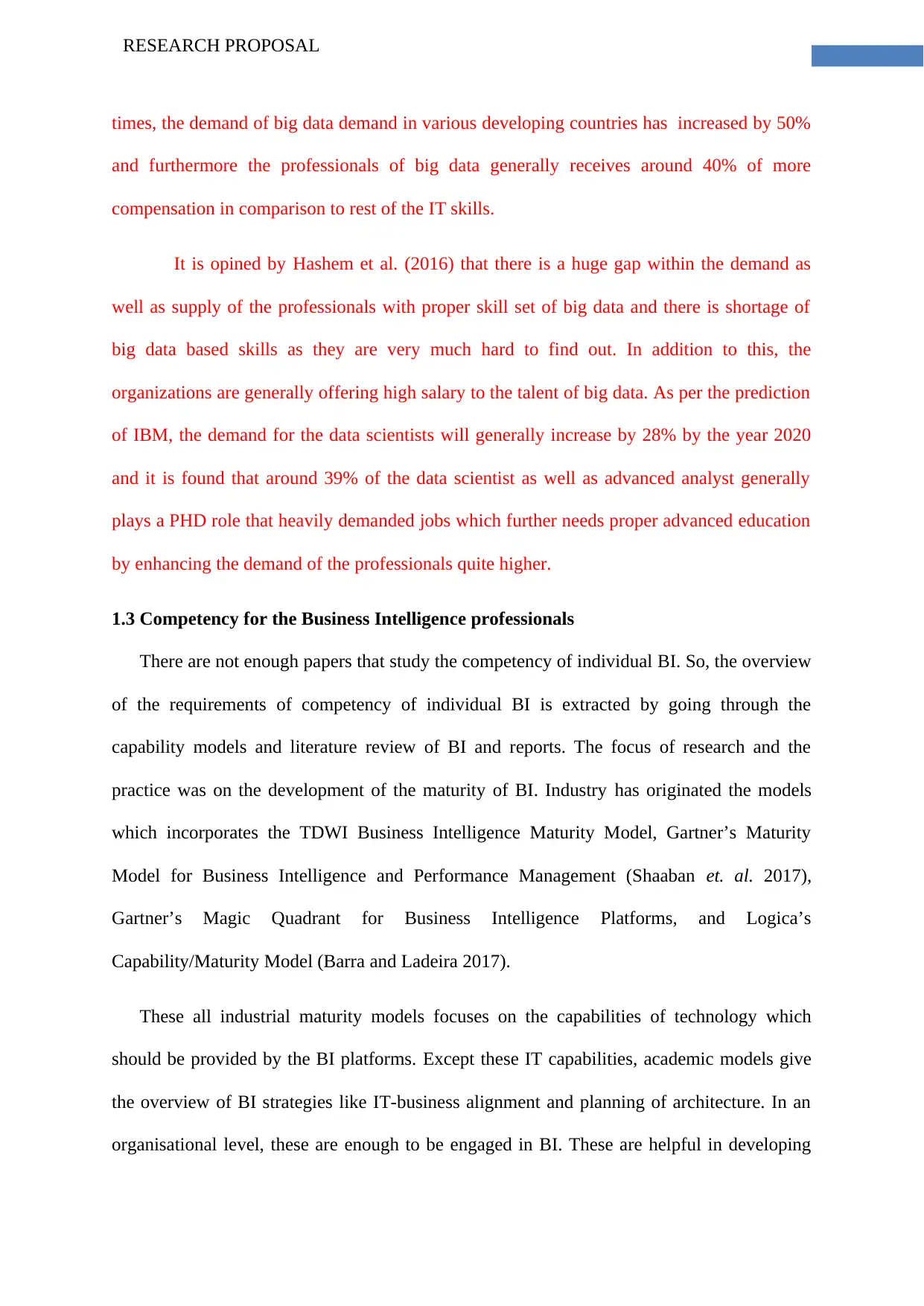
10
RESEARCH PROPOSAL
times, the demand of big data demand in various developing countries has increased by 50%
and furthermore the professionals of big data generally receives around 40% of more
compensation in comparison to rest of the IT skills.
It is opined by Hashem et al. (2016) that there is a huge gap within the demand as
well as supply of the professionals with proper skill set of big data and there is shortage of
big data based skills as they are very much hard to find out. In addition to this, the
organizations are generally offering high salary to the talent of big data. As per the prediction
of IBM, the demand for the data scientists will generally increase by 28% by the year 2020
and it is found that around 39% of the data scientist as well as advanced analyst generally
plays a PHD role that heavily demanded jobs which further needs proper advanced education
by enhancing the demand of the professionals quite higher.
1.3 Competency for the Business Intelligence professionals
There are not enough papers that study the competency of individual BI. So, the overview
of the requirements of competency of individual BI is extracted by going through the
capability models and literature review of BI and reports. The focus of research and the
practice was on the development of the maturity of BI. Industry has originated the models
which incorporates the TDWI Business Intelligence Maturity Model, Gartner’s Maturity
Model for Business Intelligence and Performance Management (Shaaban et. al. 2017),
Gartner’s Magic Quadrant for Business Intelligence Platforms, and Logica’s
Capability/Maturity Model (Barra and Ladeira 2017).
These all industrial maturity models focuses on the capabilities of technology which
should be provided by the BI platforms. Except these IT capabilities, academic models give
the overview of BI strategies like IT-business alignment and planning of architecture. In an
organisational level, these are enough to be engaged in BI. These are helpful in developing
RESEARCH PROPOSAL
times, the demand of big data demand in various developing countries has increased by 50%
and furthermore the professionals of big data generally receives around 40% of more
compensation in comparison to rest of the IT skills.
It is opined by Hashem et al. (2016) that there is a huge gap within the demand as
well as supply of the professionals with proper skill set of big data and there is shortage of
big data based skills as they are very much hard to find out. In addition to this, the
organizations are generally offering high salary to the talent of big data. As per the prediction
of IBM, the demand for the data scientists will generally increase by 28% by the year 2020
and it is found that around 39% of the data scientist as well as advanced analyst generally
plays a PHD role that heavily demanded jobs which further needs proper advanced education
by enhancing the demand of the professionals quite higher.
1.3 Competency for the Business Intelligence professionals
There are not enough papers that study the competency of individual BI. So, the overview
of the requirements of competency of individual BI is extracted by going through the
capability models and literature review of BI and reports. The focus of research and the
practice was on the development of the maturity of BI. Industry has originated the models
which incorporates the TDWI Business Intelligence Maturity Model, Gartner’s Maturity
Model for Business Intelligence and Performance Management (Shaaban et. al. 2017),
Gartner’s Magic Quadrant for Business Intelligence Platforms, and Logica’s
Capability/Maturity Model (Barra and Ladeira 2017).
These all industrial maturity models focuses on the capabilities of technology which
should be provided by the BI platforms. Except these IT capabilities, academic models give
the overview of BI strategies like IT-business alignment and planning of architecture. In an
organisational level, these are enough to be engaged in BI. These are helpful in developing
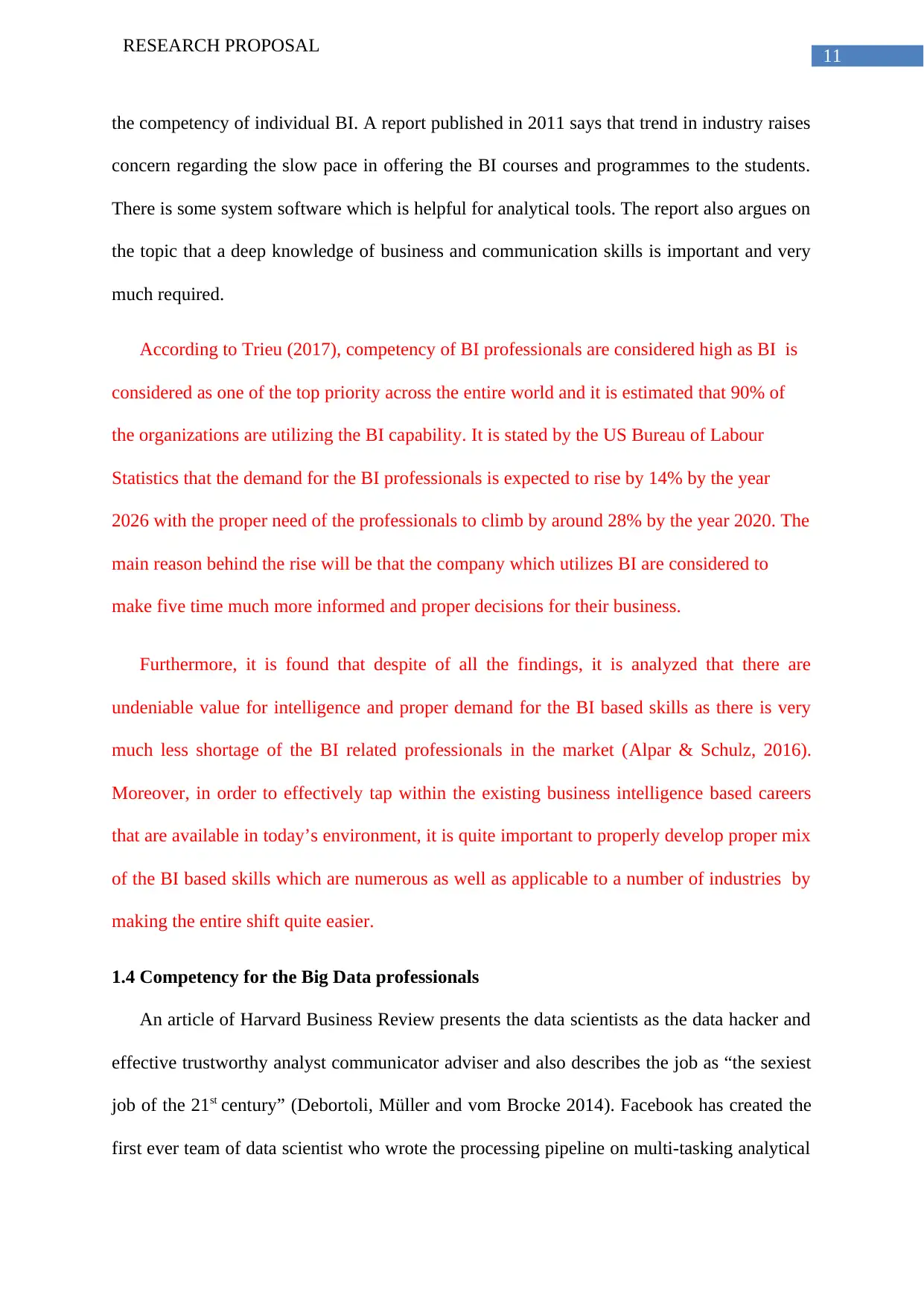
11
RESEARCH PROPOSAL
the competency of individual BI. A report published in 2011 says that trend in industry raises
concern regarding the slow pace in offering the BI courses and programmes to the students.
There is some system software which is helpful for analytical tools. The report also argues on
the topic that a deep knowledge of business and communication skills is important and very
much required.
According to Trieu (2017), competency of BI professionals are considered high as BI is
considered as one of the top priority across the entire world and it is estimated that 90% of
the organizations are utilizing the BI capability. It is stated by the US Bureau of Labour
Statistics that the demand for the BI professionals is expected to rise by 14% by the year
2026 with the proper need of the professionals to climb by around 28% by the year 2020. The
main reason behind the rise will be that the company which utilizes BI are considered to
make five time much more informed and proper decisions for their business.
Furthermore, it is found that despite of all the findings, it is analyzed that there are
undeniable value for intelligence and proper demand for the BI based skills as there is very
much less shortage of the BI related professionals in the market (Alpar & Schulz, 2016).
Moreover, in order to effectively tap within the existing business intelligence based careers
that are available in today’s environment, it is quite important to properly develop proper mix
of the BI based skills which are numerous as well as applicable to a number of industries by
making the entire shift quite easier.
1.4 Competency for the Big Data professionals
An article of Harvard Business Review presents the data scientists as the data hacker and
effective trustworthy analyst communicator adviser and also describes the job as “the sexiest
job of the 21st century” (Debortoli, Müller and vom Brocke 2014). Facebook has created the
first ever team of data scientist who wrote the processing pipeline on multi-tasking analytical
RESEARCH PROPOSAL
the competency of individual BI. A report published in 2011 says that trend in industry raises
concern regarding the slow pace in offering the BI courses and programmes to the students.
There is some system software which is helpful for analytical tools. The report also argues on
the topic that a deep knowledge of business and communication skills is important and very
much required.
According to Trieu (2017), competency of BI professionals are considered high as BI is
considered as one of the top priority across the entire world and it is estimated that 90% of
the organizations are utilizing the BI capability. It is stated by the US Bureau of Labour
Statistics that the demand for the BI professionals is expected to rise by 14% by the year
2026 with the proper need of the professionals to climb by around 28% by the year 2020. The
main reason behind the rise will be that the company which utilizes BI are considered to
make five time much more informed and proper decisions for their business.
Furthermore, it is found that despite of all the findings, it is analyzed that there are
undeniable value for intelligence and proper demand for the BI based skills as there is very
much less shortage of the BI related professionals in the market (Alpar & Schulz, 2016).
Moreover, in order to effectively tap within the existing business intelligence based careers
that are available in today’s environment, it is quite important to properly develop proper mix
of the BI based skills which are numerous as well as applicable to a number of industries by
making the entire shift quite easier.
1.4 Competency for the Big Data professionals
An article of Harvard Business Review presents the data scientists as the data hacker and
effective trustworthy analyst communicator adviser and also describes the job as “the sexiest
job of the 21st century” (Debortoli, Müller and vom Brocke 2014). Facebook has created the
first ever team of data scientist who wrote the processing pipeline on multi-tasking analytical
⊘ This is a preview!⊘
Do you want full access?
Subscribe today to unlock all pages.

Trusted by 1+ million students worldwide
1 out of 24
Related Documents
Your All-in-One AI-Powered Toolkit for Academic Success.
+13062052269
info@desklib.com
Available 24*7 on WhatsApp / Email
![[object Object]](/_next/static/media/star-bottom.7253800d.svg)
Unlock your academic potential
Copyright © 2020–2025 A2Z Services. All Rights Reserved. Developed and managed by ZUCOL.





